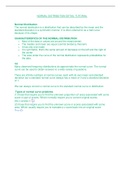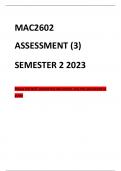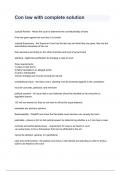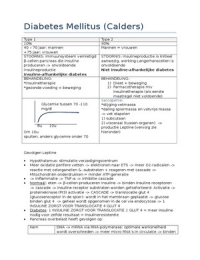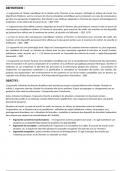MATHEMATICS 100 – Practice Problem Solutions
1. Analytically, first note that if 2 x 1 0, the inequality is automatically satisfied. So
1
part of the solution is x . For 2 x 1 0 (so that x 12 ) square both sides and
2
gather all terms on one side of the equation:
x 1 2 x 1 x 2 2 x 1 4 x 2 4 x 1 3x 2 6 x 0 3xx 2 0. Thus,
2 2
using x 0 and x 2 to divide up the number line into intervals gives the following:
The solution satisfying x 12 is 12 ,0 .
Thus, the solution to the inequality is ,0 .
Graphically, check out the graph below:
Again, the solution is ,0 .
2. This is an ugly function, but you approach the question of its domain the same way
that you should approach the question of any domain: start with all values of x and
remove any values that cause any part of the function to become undefined. Examine
each part of f x separately.
3
1
ex is defined for all x, so no restriction to the domain from this term.
x
ln is only defined provided that its argument is positive, so we need
x x 1
2
1
, x
0. First, this means that x 0, and so x 0 . Second, since the numerator
x x2 1
is now positive, we need x x 2 1 0 as well. For this quantity to even be defined, we
must have x 2 1 0, which means x must satisfy either x 1 or x 1 . Finally, we
also need x x 2 1 0. Note that for this to be true, x must be positive , since
x 2 1 0. So, for x 0, we have:
x x 2 1 0 x x 2 1 x 2 x 2 1,
which is always true.
Thus, for this part of the function f x to be defined, we must have x 1 .
arcsin e x is defined only when its argument is between -1 and +1. Since e x 0, this
means we must have e x 1 x ln1 x 0 .
Sooooo, for all parts of f x to be defined we need both x 1 and x 0. This is clearly
impossible, so the domain of f is (the empty set). (Interesting, eh? This function is
undefined for all x.)
x
3. a) We must have 0, since you can only take the ln of positive numbers. To
x 1
solve this inequality: set the top to 0 (giving x 0 ), set the bottom to 0 (giving x 1 ).
x
These numbers then divide the number line into intervals upon which is always of
x 1
one sign. Pick a point in each interval and sub it into the function:
x
, 1 : sub x 2 to find that 0
x 1
x
1,0 : sub x 12 to find that 0
x 1
x
0, : sub x 1 to find that 0
x 1
The domain of f is thus , 1 0, .
x
b) Interchange x and y in the formula y ln and solve for y:
x 1
y ex
x ln e x
y
y 1 e x
y e x
y ye x
y 1 e x
y.
y 1 y 1 1 ex
ex
Thus, f 1 x . Since e x is defined for all x, the only restriction to the domain is
1 e x
that 1 e 0 x 0. The domain of f 1 x is thus ,0 0, .
x
c) Since f and f 1 are inverse functions, the domain of one is the range of the other.
Thus, the range of f is ,0 0, , and the range of f 1 is , 1 0, .
2
, 4. y e x , x 1, 0 y e. Interchange x and y to obtain:
x e y , y 1, 0 x e y ln x, y 1, 0 x e.
y x, x 1, y 1. Again interchange x and y:
x y, y 1, x 1 y x, y 1, x 1.
The inverse function is therefore:
ln x, 0 x e
f 1 x .
x, x 1
Its domain is thus , 1 0, e.
5. i) First, the 1n causes the a n to flip signs; thus, the limit can only exist if the
remaining part of the term goes to zero. Since the higher power of n is in the
denominator, you should expect this to be the case. To prove that it is:
n 1
0 lim 1 4
n 0 n
lim n 4 1 lim
n4 n3
0.
n
lim 4
n n 1 n 1
4
n 1
1 n n 1
4 4
n n n
ii) This has the form , which is indeterminate. This means you have to simplify.
Because of the cube roots, recall the following: a 3 b 3 a ba 2 ab b 2 . Setting
a 3 n 3 n 2 1 and b 3 n 3 1 gives the following:
n 3
n 2 1 n3 1 3
n3 n2 1 3 n3 1 n3 n2 1 2/3
n3 n2 1 n
1/ 3 3
1
1/ 3
n3 1
2/
which simplifies to:
n2 n
3 3
n 2 1 3 n3 1 n3 n 2 1
2/3
n3 n 2 1 n
1/ 3 3
1 1/ 3
n3 1
2/3
or
n2
n n 1
3 2
2/3
n n 1
3 2
n
1/ 3 3
1
1/ 3
n 1 3
2/3
3 n 3 n 2 1 3 n 3 1.
Thus,
n2
lim 3 n 3 n 2 1 3 n 3 1 lim
n n
n 3
n2 1
2/3
n3 n 2 1 n
1/ 3 3
1
1/ 3
n3 1 2/3
n2
lim
n
n 1
2 1
n n13 2/3
n 2 1 1n n13 1
1/ 3 1 1/ 3
n3
n 2 1 n13
2/3
1 1
.
lim
n
1 1
n n3
1 2/3
1 1n 1
1 1/ 3
n3
1 1/ 3
n3
1
1 2/3
n3
3
6. a) This means to check whether or not the limit as n exists. For functions
involving powers of n, factor out the highest power of n from the numerator and
denominator:
3
6n 8 3n 2 cos n 3 n 8 6 3 cos n
n6 n8
n 3 6 n36 cos
n8
n
lim lim .
lim
n 4
n 9 5n 3 sin n n 4
n 9 1 56 sin9n n
n 4 1 n56 sinn9n
n n
8 9 5
Note: ; thus we have
3 4 12
3
1. Analytically, first note that if 2 x 1 0, the inequality is automatically satisfied. So
1
part of the solution is x . For 2 x 1 0 (so that x 12 ) square both sides and
2
gather all terms on one side of the equation:
x 1 2 x 1 x 2 2 x 1 4 x 2 4 x 1 3x 2 6 x 0 3xx 2 0. Thus,
2 2
using x 0 and x 2 to divide up the number line into intervals gives the following:
The solution satisfying x 12 is 12 ,0 .
Thus, the solution to the inequality is ,0 .
Graphically, check out the graph below:
Again, the solution is ,0 .
2. This is an ugly function, but you approach the question of its domain the same way
that you should approach the question of any domain: start with all values of x and
remove any values that cause any part of the function to become undefined. Examine
each part of f x separately.
3
1
ex is defined for all x, so no restriction to the domain from this term.
x
ln is only defined provided that its argument is positive, so we need
x x 1
2
1
, x
0. First, this means that x 0, and so x 0 . Second, since the numerator
x x2 1
is now positive, we need x x 2 1 0 as well. For this quantity to even be defined, we
must have x 2 1 0, which means x must satisfy either x 1 or x 1 . Finally, we
also need x x 2 1 0. Note that for this to be true, x must be positive , since
x 2 1 0. So, for x 0, we have:
x x 2 1 0 x x 2 1 x 2 x 2 1,
which is always true.
Thus, for this part of the function f x to be defined, we must have x 1 .
arcsin e x is defined only when its argument is between -1 and +1. Since e x 0, this
means we must have e x 1 x ln1 x 0 .
Sooooo, for all parts of f x to be defined we need both x 1 and x 0. This is clearly
impossible, so the domain of f is (the empty set). (Interesting, eh? This function is
undefined for all x.)
x
3. a) We must have 0, since you can only take the ln of positive numbers. To
x 1
solve this inequality: set the top to 0 (giving x 0 ), set the bottom to 0 (giving x 1 ).
x
These numbers then divide the number line into intervals upon which is always of
x 1
one sign. Pick a point in each interval and sub it into the function:
x
, 1 : sub x 2 to find that 0
x 1
x
1,0 : sub x 12 to find that 0
x 1
x
0, : sub x 1 to find that 0
x 1
The domain of f is thus , 1 0, .
x
b) Interchange x and y in the formula y ln and solve for y:
x 1
y ex
x ln e x
y
y 1 e x
y e x
y ye x
y 1 e x
y.
y 1 y 1 1 ex
ex
Thus, f 1 x . Since e x is defined for all x, the only restriction to the domain is
1 e x
that 1 e 0 x 0. The domain of f 1 x is thus ,0 0, .
x
c) Since f and f 1 are inverse functions, the domain of one is the range of the other.
Thus, the range of f is ,0 0, , and the range of f 1 is , 1 0, .
2
, 4. y e x , x 1, 0 y e. Interchange x and y to obtain:
x e y , y 1, 0 x e y ln x, y 1, 0 x e.
y x, x 1, y 1. Again interchange x and y:
x y, y 1, x 1 y x, y 1, x 1.
The inverse function is therefore:
ln x, 0 x e
f 1 x .
x, x 1
Its domain is thus , 1 0, e.
5. i) First, the 1n causes the a n to flip signs; thus, the limit can only exist if the
remaining part of the term goes to zero. Since the higher power of n is in the
denominator, you should expect this to be the case. To prove that it is:
n 1
0 lim 1 4
n 0 n
lim n 4 1 lim
n4 n3
0.
n
lim 4
n n 1 n 1
4
n 1
1 n n 1
4 4
n n n
ii) This has the form , which is indeterminate. This means you have to simplify.
Because of the cube roots, recall the following: a 3 b 3 a ba 2 ab b 2 . Setting
a 3 n 3 n 2 1 and b 3 n 3 1 gives the following:
n 3
n 2 1 n3 1 3
n3 n2 1 3 n3 1 n3 n2 1 2/3
n3 n2 1 n
1/ 3 3
1
1/ 3
n3 1
2/
which simplifies to:
n2 n
3 3
n 2 1 3 n3 1 n3 n 2 1
2/3
n3 n 2 1 n
1/ 3 3
1 1/ 3
n3 1
2/3
or
n2
n n 1
3 2
2/3
n n 1
3 2
n
1/ 3 3
1
1/ 3
n 1 3
2/3
3 n 3 n 2 1 3 n 3 1.
Thus,
n2
lim 3 n 3 n 2 1 3 n 3 1 lim
n n
n 3
n2 1
2/3
n3 n 2 1 n
1/ 3 3
1
1/ 3
n3 1 2/3
n2
lim
n
n 1
2 1
n n13 2/3
n 2 1 1n n13 1
1/ 3 1 1/ 3
n3
n 2 1 n13
2/3
1 1
.
lim
n
1 1
n n3
1 2/3
1 1n 1
1 1/ 3
n3
1 1/ 3
n3
1
1 2/3
n3
3
6. a) This means to check whether or not the limit as n exists. For functions
involving powers of n, factor out the highest power of n from the numerator and
denominator:
3
6n 8 3n 2 cos n 3 n 8 6 3 cos n
n6 n8
n 3 6 n36 cos
n8
n
lim lim .
lim
n 4
n 9 5n 3 sin n n 4
n 9 1 56 sin9n n
n 4 1 n56 sinn9n
n n
8 9 5
Note: ; thus we have
3 4 12
3


